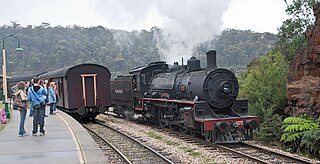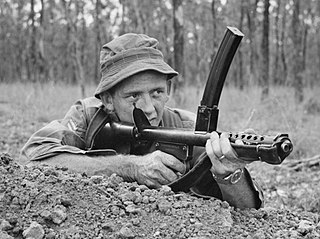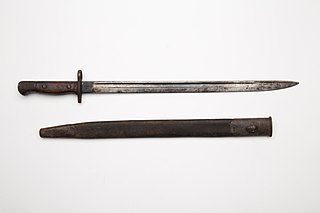
The Lee–Enfield or Enfield is a bolt-action, magazine-fed repeating rifle that served as the main firearm of the military forces of the British Empire and Commonwealth during the first half of the 20th century, and was the British Army's standard rifle from its official adoption in 1895 until 1957. The WWI versions are often referred to as the "SMLE", which is short for the common "Short, Magazine, Lee–Enfield" variant.
The University of New South Wales (UNSW), also known as UNSW Sydney, is a public research university based in Sydney, New South Wales, Australia. It is one of the founding members of Group of Eight, a coalition of Australian research-intensive universities.

Lithgow is a town in the Central Tablelands of New South Wales, Australia and is the administrative center of the City of Lithgow local government area. It is located in a mountain valley named Lithgow's Valley by John Oxley in honour of William Lithgow, the first Auditor-General of New South Wales.

The Zig Zag Railway is an Australian heritage railway, situated near Lithgow, New South Wales. It was opened by the not-for-profit Zig Zag Railway Co-op as an unpaid volunteer-staffed heritage railway in October 1975, using the alignment of the Lithgow Zig Zag line that formed part of the Main Western line between 1869 and 1910. The line climbs the western flank of the Blue Mountains, using railway zig zags to gain height.

Bankstown Airport is an airport and business park located in the City of Canterbury-Bankstown, approximately 26 km (16 mi) from the Sydney Central Business District (CBD), Australia, and 17 km (11 mi) west of Sydney Airport. It is situated on 313 ha of land and has three parallel runways, several apron areas, a small passenger terminal and a business park, home to more than 160 businesses. The airport, is home to numerous fixed-wing and helicopter flying schools and also caters to charter and private business flights, freight, aeromedical services, recreational flights, aircraft maintenance businesses, private aircraft and emergency services. Bankstown Airport operates 24 hours a day, with limitations placed on night circuit training.
Group 10 is a rugby league competition in the Central West area of New South Wales, under the auspices of the New South Wales Rugby League. It had been under the control of Country Rugby League but that changed after the NSWRL agreed to a new constitution and the CRL voted to wind up its affairs immediately. The decisions was made on 19 October 2019 and the merger means that the aim of a unified administration of the sport in NSW was achieved over a year ahead of time.

The F1 is a 9x19mm Australian submachine gun manufactured by the Lithgow Small Arms Factory. First issued to Australian troops in July 1963, it replaced the Owen machine carbine.
The New South Wales 85 class were a class of 10 electric locomotives built by Comeng, Granville between May 1979 and July 1980 for the Public Transport Commission.

The Southern Aurora was an overnight express passenger train that operated between Australia's two largest cities, Sydney and Melbourne. First-class throughout, including the dining facilities, the Southern Aurora featured all-sleeper accommodation. The train first ran on 13 April 1962 after the opening of the North East standard gauge line from Melbourne to Albury, eliminating the break-of-gauge between the capital cities.
The Lithgow Small Arms Factory, or Lithgow Arms, is an Australian small arms manufacturing factory located in the town of Lithgow, New South Wales. It was created by the Australian Government in 1912 to ease reliance on the British for the supply of defence materials.

Douglas Grant was an Aboriginal Australian soldier, draughtsman, public servant, journalist, public speaker, and factory worker. During World War I, he was captured by the German army and held as a prisoner of war at Wittenberg, and later at Wünsdorf, Zossen, near Berlin.

The L1A1 Self-Loading Rifle, officially "Rifle, 7.62mm, L1A1", also known just as the SLR, by the Canadian Army designation C1A1 (C1) or in the US as the "inch pattern" FAL, is a British version of the FN FAL battle rifle produced by the Belgian armaments manufacturer FN Herstal. The L1A1 was produced under licence and has seen use in the Australian Army, Canadian Army, Indian Army, Jamaica Defence Force, Malaysian Army, New Zealand Army, Rhodesian Army, Singapore Army and the British Armed Forces.
In Australia, a Union Church is a church building owned and maintained by a local trust and available to multiple denominations.

My Pet Dinosaur is a 2017 Australian adventure family film written and directed by Matt Drummond, and produced by Megan Williams.

The defence industry of Australia provides military equipment, supplies and services for the Australian Defence Force (ADF) and export customers. Definitions of what the defence industry comprises and estimates of its size differ, but it was believed to have employed between 12,000 and 29,000 people as of the mid 2010s. The industry has grown over recent years, and Australian Defence Magazine reported that the 40 largest companies had a total revenue of $A 9.2 billion in 2015.

The Lithgow Heavy Anti Aircraft Gun Stations and Dummy Station is a heritage-listed former gun emplacements, anti aircraft gun batteries and dummy batteries and now disused railway signal box located via Kirkley Street, Bowenfels, City of Lithgow, New South Wales, Australia. It was built from 1941 to 1942 by Water Conservation & Irrigation Commission, Defence. It is also known as Lithgow Anti Aircraft Gun Emplacements and Heavy Anti Aircraft guns 3.7 inch anti aircraft guns. The property is owned by Lithgow City Council. It was added to the New South Wales State Heritage Register on 5 August 2011.

The Cooerwull railway footbridge is a heritage-listed pedestrian bridge located at Top Points Station, Zig Zag Railway, Lithgow, City of Lithgow, New South Wales, Australia. It was built in 1941. It was added to the New South Wales State Heritage Register on 2 April 1999.

The Pattern 1907 bayonet, officially called the Sword bayonet, pattern 1907 , was a British bayonet designed to be used with the Short Magazine Lee Enfield (SMLE) rifle. The Pattern 1907 bayonet was used by the British and Commonwealth forces throughout both the First and Second World Wars.

Australian heraldry is the term for the style of armorial achievements, sometimes known as coats of arms, and other heraldic bearings and insignia used in Australia. It largely follows the Gallo-British tradition of heraldry also followed in England, Scotland, Ireland, Canada and New Zealand.
















